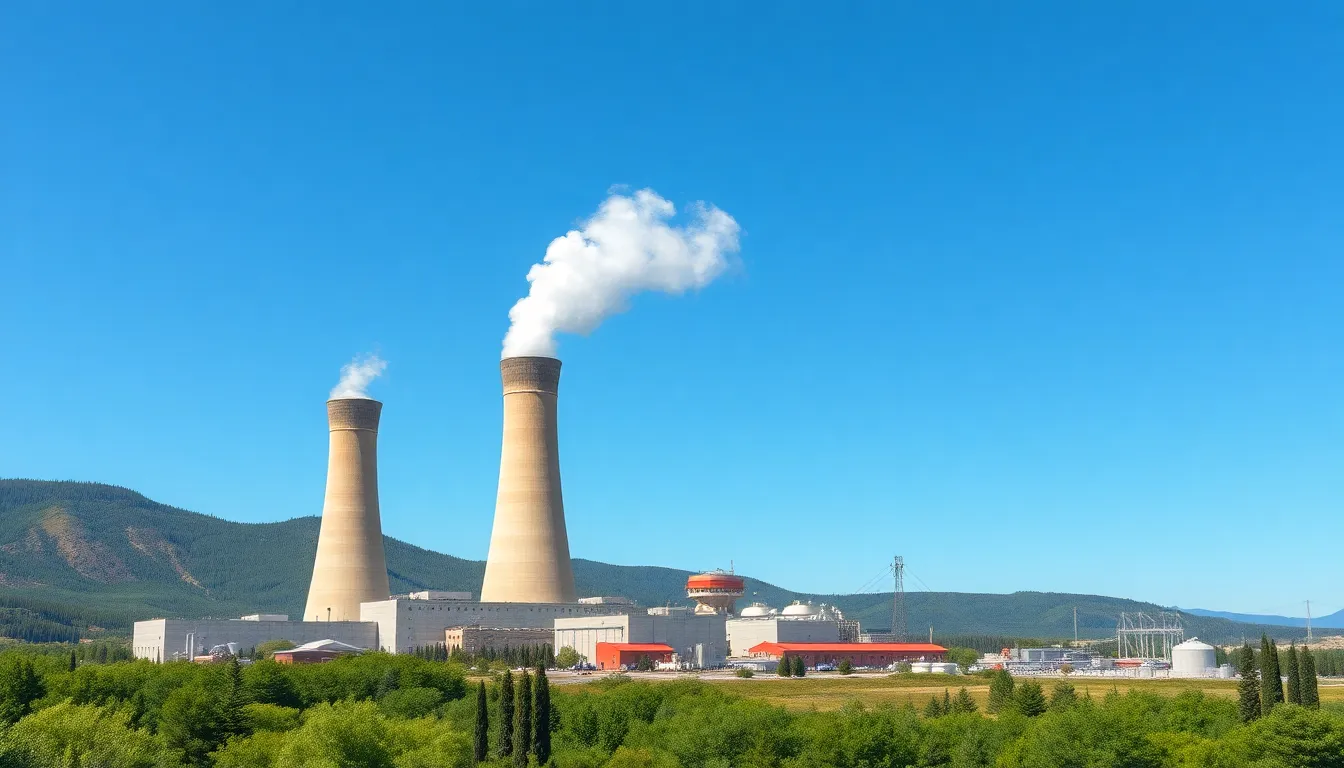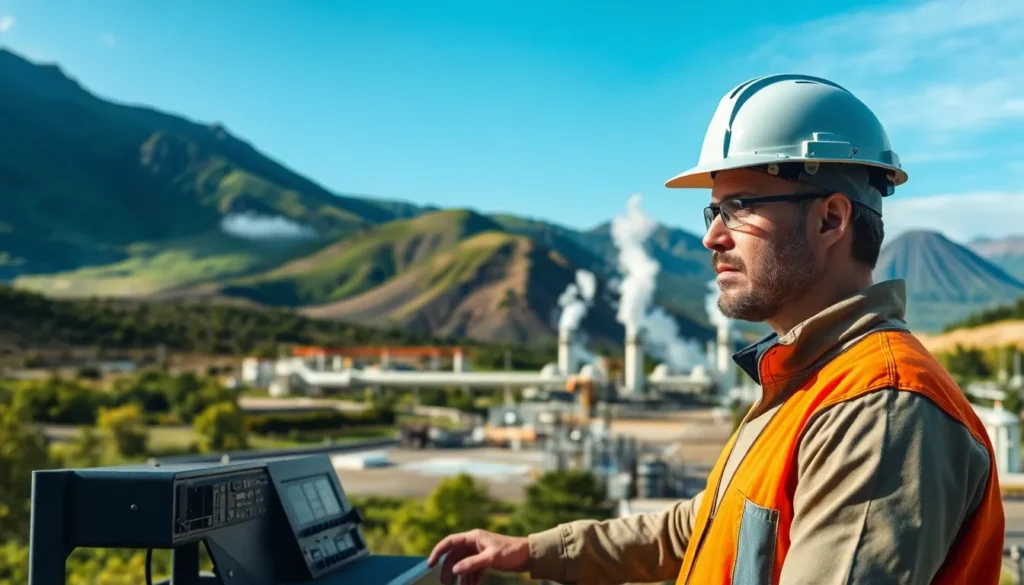Table of Contents
ToggleGeothermal energy is a powerful yet often overlooked renewable resource. Tapping into the Earth’s internal heat, it offers a sustainable way to generate electricity and provide heating. As the world grapples with climate change and seeks cleaner energy alternatives, geothermal energy stands out for its reliability and low environmental impact.
This energy source harnesses heat from beneath the Earth’s surface, making it a consistent and abundant option. With advancements in technology and increased investment, geothermal energy is gaining traction as a viable solution for reducing dependence on fossil fuels. Understanding its potential can pave the way for a greener future.
Overview of Geothermal Energy
Geothermal energy harnesses the Earth’s internal heat, providing a consistent and sustainable power source. It originates from the planet’s formation and the radioactive decay of minerals, creating a continuous flow of heat. This geothermal heat can transform into electricity or be used directly for heating purposes.
Geothermal power plants generally fall into three categories:
- Dry Steam Plants: Utilize steam from geothermal reservoirs to drive turbines, generating electricity.
- Flash Steam Plants: Extract high-pressure hot water from the Earth, allowing it to ‘flash’ into steam when pressure decreases, powering turbines.
- Binary Cycle Plants: Operate using a secondary fluid with a lower boiling point, exchanging heat from geothermal water to generate electricity without direct exposure to steam.
This renewable energy source offers significant advantages. Geothermal energy systems provide a stable base load of power, contrasting with the intermittent nature of wind and solar energy. Additionally, they emit minimal greenhouse gases. According to the U.S. Department of Energy, geothermal power plants contribute less than 0.1% of total U.S. greenhouse gas emissions.
The potential for geothermal energy is vast. The International Renewable Energy Agency estimates that global capacity could reach 200 gigawatts (GW) by 2050, with advancements in enhanced geothermal systems (EGS) expanding access to this resource. Countries like the United States, Indonesia, and the Philippines currently lead in geothermal energy production.
Geothermal energy’s reliability and environmental benefits align with global sustainability goals. It offers an alternative to fossil fuels while supporting efforts to combat climate change. The growth of this renewable resource reflects its pivotal role in developing a sustainable energy landscape.
Types of Geothermal Energy

Geothermal energy is categorized into two main types based on temperature ranges: low-temperature geothermal resources and high-temperature geothermal resources. Each type serves distinct applications and has unique characteristics.
Low-Temperature Geothermal Resources
Low-temperature geothermal resources typically range from 50°F to 300°F (10°C to 150°C). These resources are often utilized for direct heating applications, district heating systems, greenhouse heating, and aquaculture. Examples include ground-source heat pumps, which leverage the Earth’s stable subsurface temperatures for residential and commercial heating and cooling. They provide efficient heating solutions and contribute to energy savings.
High-Temperature Geothermal Resources
High-temperature geothermal resources exceed 300°F (150°C) and are primarily used for electricity generation. These resources are found in regions with volcanic activity, such as the United States, Iceland, and parts of the Philippines. High-temperature geothermal plants can include dry steam plants that directly utilize steam from the ground, flash steam plants that convert high-pressure hot water into steam, and binary cycle plants that use a secondary fluid with a lower boiling point to generate power. These plants efficiently produce significant electricity and offer a reliable, clean energy source.
Benefits of Geothermal Energy
Geothermal energy offers numerous advantages that contribute to sustainability and economic stability. Its environmental and economic benefits make it a vital player in the transition to renewable energy sources.
Environmental Advantages
Geothermal energy presents substantial environmental benefits. It emits negligible greenhouse gases, contributing less than 0.1% to total U.S. emissions. Compared to fossil fuel energy, geothermal energy significantly reduces air pollution, which enhances public health and environmental quality. Additionally, geothermal power plants require minimal land use, preserving landscapes and ecosystems. The utilization of geothermal resources can also enhance water conservation, as closed-loop systems often recycle water instead of discharging it. Furthermore, geothermal energy production does not generate harmful waste products, contributing to a cleaner energy landscape.
Economic Benefits
Geothermal energy promotes economic growth and job creation. The U.S. geothermal sector supports over 20,000 jobs, spanning various fields including engineering, drilling, and plant operation. Geothermal energy projects stimulate local economies through investments in infrastructure and services. Additionally, geothermal energy provides stable energy prices, lessening the impact of volatile fossil fuel markets. The long operational lifespan of geothermal plants, typically lasting over 30 years, ensures continued economic returns. As investment in geothermal technologies increases, the potential for further economic expansion remains high, enhancing energy independence and resilience.
Challenges in Geothermal Energy Utilization
Geothermal energy faces various challenges that can hinder its broader adoption and effectiveness. Key issues include technical complexities and regulatory hurdles that impact project development.
Technical Challenges
Technical challenges include resource exploration, drilling, and plant operation. Resource exploration requires advanced geological and geophysical surveys to identify suitable sites. This process can be costly and time-consuming. Drilling represents another significant challenge; deep wells often reach temperatures above 300°F, and high-pressure conditions can lead to equipment failures or blowouts. Additionally, maintaining operational efficiency in geothermal power plants demands sophisticated technology, particularly in managing reservoir pressure and heat transfer. The potential for induced seismicity, associated with fluid injection or extraction, further complicates the operational landscape. Addressing these technical challenges is crucial for maximizing geothermal energy’s potential.
Regulatory and Policy Issues
Regulatory and policy issues present another significant barrier to geothermal energy development. The permitting process for geothermal projects often involves multiple stakeholders, including local, state, and federal agencies. This intricacy can create delays and increase project costs. Additionally, mismatched regulations across jurisdictions complicate project planning and execution. Tax incentives and funding opportunities may also vary, influencing investor confidence. Ensuring policies support innovation and streamline permitting is essential to fostering geothermal energy growth and attractiveness as a sustainable energy source.
Future of Geothermal Energy
The future of geothermal energy looks promising, driven by technological advancements and an increasing demand for sustainable energy sources. Both innovations in geothermal technology and potential market growth play vital roles in shaping this sector.
Technological Innovations
Technological innovations enhance geothermal energy efficiency and accessibility. Improving drilling techniques, such as enhanced geothermal systems (EGS), enable access to previously untapped resources by creating reservoirs in low-permeability rock. Next-generation binary cycle power plants maximize energy extraction while minimizing environmental impact. Additionally, automation and advanced data analytics optimize geothermal operations, increasing reliability and reducing operational costs. Furthermore, the integration of geothermal systems with renewable technologies, such as solar and wind, can create hybrid energy systems, diversifying energy supply and improving overall energy resilience.
Potential Market Growth
Potential market growth for geothermal energy is significant, guided by global climate initiatives and energy policies. The International Renewable Energy Agency anticipates a global geothermal capacity of 200 gigawatts (GW) by 2050, a strong increase aimed at energy transition. Countries, including the United States, Indonesia, and Philippines, lead in geothermal production, driven by supportive regulations and investment. Furthermore, cities increasingly adopt geothermal for district heating systems, boosting local adoption. The emergence of geothermal startups and innovative financing models also suggests untapped opportunities, fostering sector expansion as demand for low-carbon energy solutions escalates.
Geothermal energy stands as a formidable player in the quest for sustainable energy solutions. Its ability to provide reliable power while minimizing environmental impact positions it as a key alternative to fossil fuels. As technological advancements continue to emerge and investments grow, the potential for geothermal energy expands significantly.
With a promising future ahead, the integration of geothermal systems into broader energy strategies could enhance energy security and contribute to global sustainability goals. The ongoing efforts to overcome existing challenges will be crucial in unlocking geothermal energy’s full potential. This renewable resource not only supports economic growth but also plays a vital role in combating climate change.







